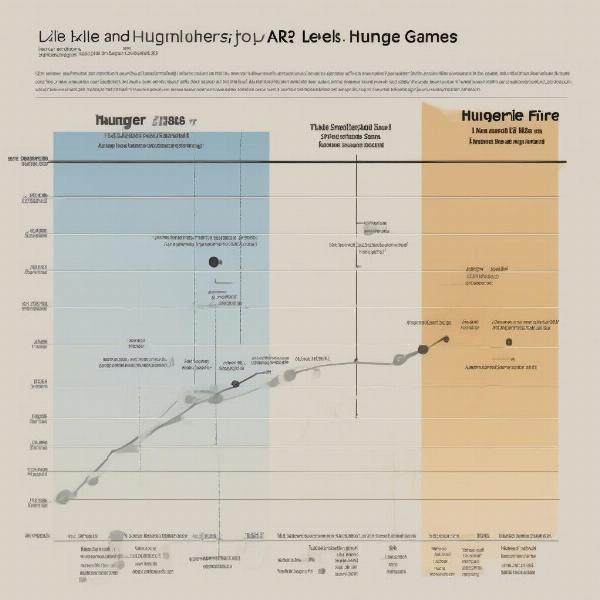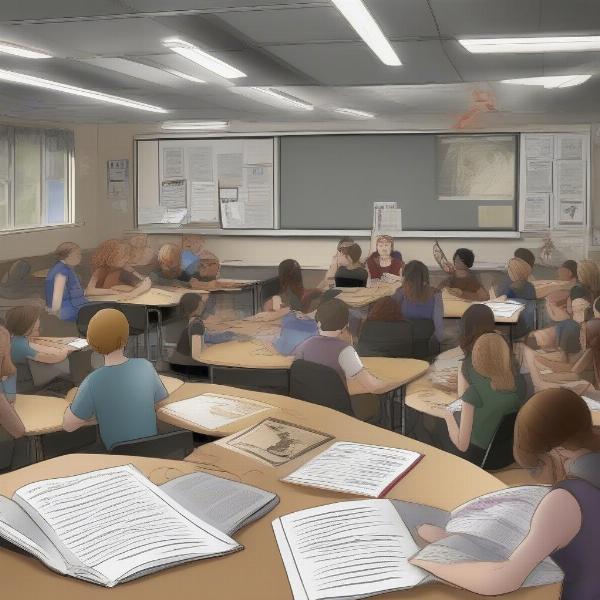The Hunger Games trilogy, a captivating series by Suzanne Collins, has enthralled readers worldwide. But What Is The Reading Level Of Hunger Games? This question often arises, particularly from parents and educators seeking appropriate books for younger readers. Understanding its complexity helps determine its suitability for various age groups and reading abilities.
Decoding the Reading Level of The Hunger Games
Assessing reading level involves several factors, not just vocabulary. Sentence structure, themes, and the presence of figurative language all contribute. The Hunger Games, while written in relatively accessible language, explores mature themes such as survival, oppression, and violence. This complexity adds another layer to understanding its appropriate audience.
The generally accepted reading level for The Hunger Games is around grades 5-8 (ages 10-14). Tools like Lexile and AR (Accelerated Reader) place it within this range, typically scoring between 800L and 950L. However, these are just guidelines. A child’s maturity level and prior reading experiences play a crucial role in their comprehension and engagement with the series.
 The Hunger Games book cover displaying the mockingjay symbol
The Hunger Games book cover displaying the mockingjay symbol
Understanding the Lexile and AR Levels
Lexile and AR are two common readability measurement tools used by educators. Lexile measures text complexity, while AR assesses both text difficulty and comprehension. While helpful, they shouldn’t be the sole determinants. They offer a starting point, but a child’s emotional maturity and ability to handle complex themes should also be considered. For example, while the vocabulary might be accessible to a fifth-grader, the violent content might be more suitable for a more mature reader.
A crucial aspect of readability is understanding the context. The Hunger Games presents a dystopian society with complex political systems and social dynamics. While the surface narrative is about survival, the underlying themes delve into deeper issues. This adds a layer of complexity that may require guidance and discussion for younger readers.
 Chart depicting the reading levels of The Hunger Games trilogy based on various metrics
Chart depicting the reading levels of The Hunger Games trilogy based on various metrics
Beyond the Numbers: Considering Maturity and Themes
While readability scores provide a framework, the maturity of the themes in The Hunger Games warrants careful consideration. The violence, though not excessively graphic, is a constant presence. The psychological impact of the Games on the characters, including PTSD and anxiety, is also explored. These elements, while contributing to the story’s power, require a level of emotional maturity to process.
Jennifer Thompson, a middle school librarian with 15 years of experience, notes, “The Hunger Games can be a powerful tool for sparking discussions about important social issues. However, it’s crucial to consider the individual child’s maturity level. Open communication between parents, educators, and the child is key.” Her insights highlight the importance of going beyond the numerical reading level.
Is The Hunger Games Right for Your Child?
Ultimately, the decision of whether The Hunger Games is suitable for a particular child rests with the parents or guardians. Understanding the reading level is just one piece of the puzzle. Considering the child’s maturity, reading habits, and ability to handle complex themes will help determine if they are ready for the world of Panem. Open conversations and guidance can enrich the reading experience and facilitate deeper understanding.
 A group of students discussing The Hunger Games in a classroom setting
A group of students discussing The Hunger Games in a classroom setting
Exploring Related Themes: Dystopian Literature for Young Adults
Dystopian fiction offers a compelling lens for exploring complex societal issues. The Hunger Games, Divergent, and The Maze Runner are prime examples that have captured young readers’ imaginations. What makes these stories so engaging?
The Allure of Dystopian Worlds
Dystopian literature often presents a seemingly perfect society that harbors dark secrets. This contrast intrigues readers and sparks critical thinking about their own world. Exploring themes of control, rebellion, and the importance of individual choice can be both thrilling and thought-provoking.
The Role of Young Adult Literature in Shaping Perspectives
Young adult literature plays a crucial role in shaping young minds. By grappling with complex issues in a fictional setting, readers develop empathy and critical thinking skills. Dystopian stories, in particular, can prompt discussions about social justice, ethics, and the power of individual action.
Conclusion
So, what is the reading level of Hunger Games? While technically aimed at grades 5-8, the thematic complexity requires consideration of the reader’s maturity and emotional readiness. It’s more than just vocabulary; it’s about understanding the nuanced world that Suzanne Collins created. By considering these factors, parents and educators can help ensure a positive and enriching reading experience. Discuss the book with your child, explore the themes together, and unlock the powerful messages within its pages. What are your thoughts on the suitability of The Hunger Games for different age groups? Share your perspectives in the comments below!
FAQ
- What age is appropriate for reading The Hunger Games? While the reading level suggests ages 10-14, considering the mature themes, 12+ might be more suitable for some.
- Is The Hunger Games too violent for kids? The violence, while not gratuitous, is a central theme. Parents should consider their child’s sensitivity to such content.
- What are the main themes of The Hunger Games? Survival, oppression, rebellion, social inequality, and the power of hope are key themes explored in the series.
- What are some similar books to The Hunger Games? Divergent, The Maze Runner, and The Giver are often recommended for readers who enjoyed The Hunger Games.
- Are there resources available to help guide discussions about The Hunger Games? Yes, many online resources and educational guides offer discussion prompts and activities for exploring the book’s themes.
- How can I determine if The Hunger Games is suitable for my child? Consider their reading level, maturity, and ability to handle complex themes. Open communication is key.
- Where can I find the Lexile or AR level for The Hunger Games? These can be found on the Lexile and Renaissance Learning websites, respectively.

